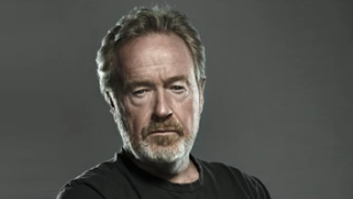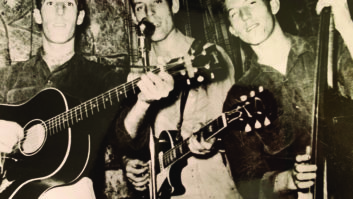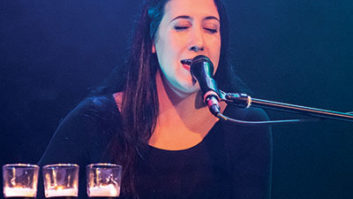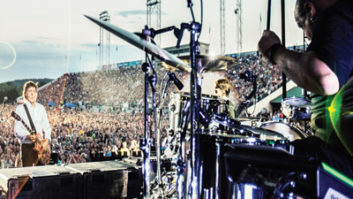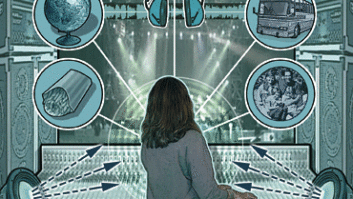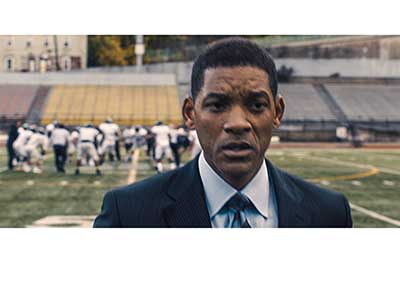
Director Peter Landesman‘s Concussion, distributed by Columbia Pictures, is a sports drama starring Will Smith as Nigerian-born forensic neuropathologist Dr. Bennet Omalu, whose research on concussion-caused brain damage led to the discovery of CTE, or chronic traumatic encephalopathy, a progressive and degenerative disease found in people with a history of repetitive brain trauma. Like NFL football players. That’s the main story line.
Behind the scenes, and for the past decade, the National Football League has been challenging the studies on CTE, and, since last April when first reported, challenging the content of the film. The controversy will no doubt fuel the box office for Concussion, when it opens December 25, just in time for the playoffs.
But there’s an even further-behind-the scenes story involving the film’s sound team, which includes, as re-recording mixers, Michael and Christian P. Minkler; mixing is in their blood. Michael and Christian, father and son, are part of the Minkler mixing legacy that includes re-recording mixers Don Minkler (Michael’s father), known for Easy Rider; Bob Minkler (Michael’s uncle) known for Star Wars: Episode IV—A New Hope; and Lee Minkler (Michael’s other uncle), known for TRON. Bob, Lee, and Michael—all members of the TRON sound mixing team—were nominated for an Oscar together for Best Sound on that film.
Michael and Christian, both now a part of Sony Pictures Studios, have teamed up to mix three top-billing box-office films in 2015: Insurgent, Concussion and The Hateful Eight. While none were their first time sharing the dub stage—back in 1994 they mixed Natural Born Killers together with re-recording mixer Tom Fleischman—2015 was the first time they mixed films together on more equal ground. Natural Born Killers was Christian’s first credit as re-recording mixer while Michael had more than two decades of mixing experience at that point.

“Almost 20 years [ago] we worked together, but felt maybe it wasn’t really a good thing to do so,” admits Michael, who has won three Oscars for Best Sound. Now, Christian’s re-recording career spans over two decades, and includes films like Babel, Gone Baby Gone and August: Osage County. “I have heard people say, ‘Chris is great; we had a great experience,’” says Michael. “Now, I get to seriously enjoy that on a daily basis. He is very talented and very sweet to work with. I love working with Chris and I really enjoy how his talents have come such a long way.”
Christian says his father has been his mentor almost his whole life and that his father’s mixing style is the basis of his own. So when they teamed up again on the mix stage for Concussion, Christian says, “It was very familiar, which made it very comfortable. [Michael’s] style of mixing really fit into the workflow and the sound that I am accustomed to creating. This was probably the best professional year I ever had, working alongside my father, who I consider the best mixing talent in the world.”
Concussion’s supervising sound editor Dave McMoyler, at Formosa Group in West Hollywood, says mixing with the Minklers was one of the most pleasurable experiences he’s had: “There almost seems to be an unspoken connection between them, almost intuitive. I don’t know if it’s because genetically they are from the same source material but they just work seamlessly together. When Mike needs some help, it’s almost like he doesn’t have to ask because Chris is already on it.”
As with his debut film Parkland (2013), Landesman chose composer James Newton Howard to write the score. Michael, who worked with Landesman and Howard on Parkland, as well as handled the theatrical mix of Howard’s score on several prior releases, says the score on Concussion was the best he’s ever written. “The execution and emotion that it carries is incredible. I hope he gets a lot of attention for his work on this film,” Michael says.

On Concussion, McMoyler mainly delivers reality-based sound design, particularly of the Pittsburgh cityscape, and subtle sound effects to support the drama. “Sound editors are like the Rodney Dangerfield of the industry, in that if we are really doing our job right, you won’t know that we have done anything. This film, probably more so than others, was about subtlety, but it was also about strongly supporting the emotional importance of each scene,” says McMoyler, who collaborated with Landesman and film editor William Goldenberg on the direction for sound.
While overall realism reigned, there were a few artistic instances where sound stretched into subjective territory. Christian, who handled the sound effects/Foley/backgrounds in the mix, notes that one of the trickiest sections to mix was when the characters who are suffering from CTE go into their dementia moments. “None of us have experienced that. We created what this condition would feel like, not having any reference at all,” says Christian. “We kept asking ourselves, ‘Is this correct? Is this working? Are we relaying to the audience what these people are suffering?’ That was probably the biggest challenge, and I think we pulled it off nicely.”
In another sequence that stood out for Christian, football player Mike Webster (played by David Morse) is losing his mind. Scenes of the player destroying his house and fighting with his family are intercut with scenes of a football game. “It ends with the real image of how he died, and to me, when I first saw that, it kind of really shook me up,” says Christian.

Michael’s favorite scene to mix was a five-minute montage of Dr. Omalu piecing together the connection of brain trauma and football. “It’s wonderfully put together by Billy [Goldenberg] and Peter [Landesman]. This is an extremely emotional film, and that’s the scene that gets me, other than the last scene, which I have cried all the twenty-some times I’ve seen it,” Michael says.
Michael and Christian mixed Concussion at Sony Pictures Studios in The Burt Lancaster Theater on a Harrison MPC4-D Digital Console. “Sony has been deeply embedded in the Harrison console world since 1995 or 1996,” says Michael. “We wanted to do a big sound, and the engineers [at Sony] were great in adapting the consoles for what Chris and I wanted to do.”
Specifically, Christian explains, they wanted to stay within Pro Tools, and so Sony adapted to that workflow. “We wanted to use the Avid S6 console, but it wasn’t ready at the time so I chose to use the Avid Artist mix to carry along with me,” explains Christian. “Dave [McMoyler], his editing team, and I were able to, from beginning to end, stay within Pro Tools. Then, during the final, I was utilizing the Harrison console.”
In the age of Dolby Atmos, DTS:X, Barco Auro-3D and IMAX 12.0, it seems that nearly every film’s mix is being pushed into large-scale immersive formats, but that’s not the case with Concussion. McMoyler notes they chose to mix the film in 5.1. “We tried to find what is appropriate and this is why I love working with Mike and Chris. They don’t overplay their hand.”
In utilizing the 5.1 surround field on the effects side of the board, Christian was able to pull the backgrounds, walla, and specific featured effects into the theater. For example, during the sequence where the film takes the audience inside the brain as it is being shattered, Christian explains, “We go from a small, realistic portrayal, and as the scene builds, the soundtrack builds along with it. Eventually the room is shaking, and the surrounds are pumping to the visuals. We were able to get the same feeling in 5.1 as we would have with a 7.1 mix.”
